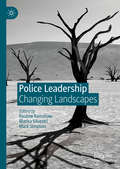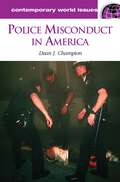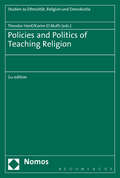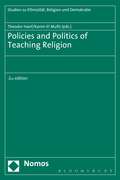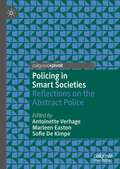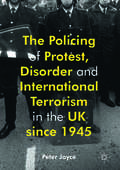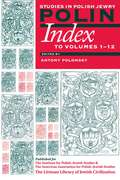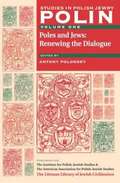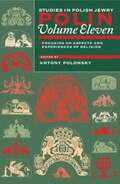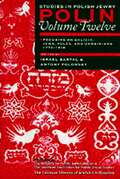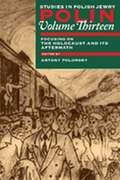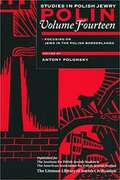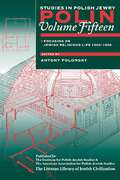- Table View
- List View
The Poisonwood Bible: Response Journal (Oprah's Book Club Ser.)
by Barbara KingsolverBarbara Kingsolver's acclaimed international bestseller tells the story of an American missionary family in the Congo during a poignant chapter in African history. It spins the tale of the fierce evangelical Baptist, Nathan Price, who takes his wife and four daughters on a missionary journey into the heart of darkness of the Belgian Congo in 1959. They carry with them to Africa all they believe they will need from home, but soon find that all of it - from garden seeds to the King James Bible - is calamitously transformed on African soil. Told from the perspective of the five women, this is a compelling exploration of African history, religion, family, and the many paths to redemption. The Poisonwood Bible was nominated for the Pulitzer Prize in 1999 and was chosen as the best reading group novel ever at the Penguin/Orange Awards. It continues to be read and adored by millions worldwide.
POLARITIES IN THE EVOLUTION OF HUMANITY: West and East – Materialism and Mysticism – Knowledge and Belief
by Rudolf Steiner‘The present age needs to understand that human beings must hold the balance between the two extremes, between the ahrimanic and the luciferic poles. People always tend to go in one direction... The Christ stands in the middle, holding the balance.’– Rudolf SteinerThese eleven lectures were given in post-war Stuttgart against a backdrop of struggle and uncertainty – not only within society at large but also within the anthroposophical movement. Rudolf Steiner and his supporters were working to introduce ‘threefold’ social ideas and – given Steiner’s public profile – were coming under increasing personal and sometimes physical attack.Steiner responds to this turbulent situation by revealing the spiritual background to the forces of decline working in contemporary civilization. He speaks of retrogressive powers – spiritual beings referred to as luciferic or ahrimanic – that work directly into human culture, manifesting, for example, in what he refers to as the ‘initiation streams’ of Western secret societies, the Church-allied impulse of Jesuitism and the Bolshevik force of Leninism. The spiritual agents of adversity also encourage polarised thinking and false opposites such as East verses West, materialism and mysticism, or knowledge and belief. Only the threefold principle – represented by Christ – allows us to create a balance in the midst of these existential conflicts.This freshly-reworked translation is complemented with notes, an index and an introduction by Matthew Barton.
Police Leadership: Changing Landscapes
by Marisa Silvestri Mark Simpson Pauline RamshawThis book draws upon a range of theoretical and empirical research to explore contemporary debates about police leadership. Focusing upon leadership styles, ethics, integrity and professionalism, workforce diversity, legitimacy and accountability, it reviews the changing context and nature of leadership over time and explores the gains, losses, tensions and challenges that different leadership models bring to policing. Leadership is present at various levels within the police service and this collection reflects upon appropriate leadership qualities and requirements for different roles and at different ranks. The book also considers the difference between leadership and management in an attempt to capture fuller debates within police leadership. Part one surmises the contextual backdrop to current thinking and the primary challenges facing leadership in the police service. Part two highlights the changing face of leadership through an exploration of the call for greater diversity within the ranks of police leadership, and the final section examines police leadership beyond England and Wales. Through this, Police Leadership explores how the challenges facing police leadership in England and Wales share similarities with those in Scotland, Northern Ireland, Greece, North America, and Australia in the face of the pressures of political and economic uncertainty.
Police Misconduct in America: A Reference Handbook (Contemporary World Issues)
by Dean John ChampionWith just the right dose of academic pragmatism, Police Misconduct in America assesses the history of police excesses from 1900 to the present.At the dawn of the profession, police officers initially were hired based on physical strength, not personal skills. They did not understand the laws they were enforcing or how laws should be enforced. This extensive survey examines the context and types of police misconduct since the 1900s.Written by Dean J. Champion, Police Misconduct in America covers police history back to Mesopotamia, outlines controversies, provides a broad chronology of significant eras in police history and a timeline of specific events, and offers biographical sketches of key personalities from J. Edgar Hoover to Alice Stebbens Wells, the first American policewoman. It also includes are summaries of key Supreme Court cases, an extensive list of organizations concerned about police misconduct, government documents and agency publications, and other references.
Police Socialisation, Identity and Culture: Becoming Blue
by Sarah CharmanThis book reinvigorates the debate about the origins and development of police culture within our changing social, economic and political landscape. An in-depth analysis and appreciation of the police socialisation, identity and culture literature is combined with a comprehensive four-year longitudinal study of new recruits to a police force in England. The result offers new insights into the development of, and influences upon, new police recruits who refer to themselves as a “new breed” of police officer. Adding significantly to the police culture literature, this original and empirically based research also provides valuable insights into the challenges of modern policing in an age of austerity. Scholars of policing and criminal justice, as well as police officers themselves will find this compelling reading.
Police Socialisation, Identity and Culture: Becoming Blue
by Sarah CharmanThis book reinvigorates the debate about the origins and development of police culture within our changing social, economic and political landscape. An in-depth analysis and appreciation of the police socialisation, identity and culture literature is combined with a comprehensive four-year longitudinal study of new recruits to a police force in England. The result offers new insights into the development of, and influences upon, new police recruits who refer to themselves as a “new breed” of police officer. Adding significantly to the police culture literature, this original and empirically based research also provides valuable insights into the challenges of modern policing in an age of austerity. Scholars of policing and criminal justice, as well as police officers themselves will find this compelling reading.
Policies and Politics of Teaching Religion (Studies in Ethnicity, Religion and Democracy)
by Theodor Hanf Karim El MuftiIn states in which the public role of religion is controversial, religious instruction becomes both a means and an end of politics. This groundbreaking collection of case studies drawn from Arab, Asian and European countries examines different aspects of religious instruction: how it is regulated, who decides its content, the values it imparts and, in particular, whether it triggers, deepens or reduces conflict.
Policies and Politics of Teaching Religion (Studies in Ethnicity, Religion and Democracy)
by Theodor Hanf Karim El MuftiIn states in which the public role of religion is controversial, religious instruction becomes both a means and an end of politics. This groundbreaking collection of case studies drawn from Arab, Asian and European countries examines different aspects of religious instruction: how it is regulated, who decides its content, the values it imparts and, in particular, whether it triggers, deepens or reduces conflict.
Policing in Smart Societies: Reflections on the Abstract Police (Palgrave's Critical Policing Studies)
by Antoinette Verhage Marleen Easton Sofie De KimpeSmart societies pose new challenges for police organizations. Demands for more efficiency and effectiveness test police organizations which are often resistant to change. This book uses the concept of the abstract police to describe the way in which police organizations have tried to adapt to these new evolutions and the consequences. The chapters stem from a conference called “Street Policing in a Smart Society” which sought to frame and analyse these developments in policing. In this book, the concept of the abstract police is introduced, analysed and then challenged from different angles, looking at the evolutions related to technology, plural policing, police discretion and police decision making. As such, the book is a reflection of current debates on policing and police organization, aiming to give input to the debate by providing new insights on police and police work.
The Policing of Protest, Disorder and International Terrorism in the UK since 1945
by Peter JoyceThis book examines the nature of protest and the way in which the police and state respond to the activities associated with this term. Protest is explored within the context of the perceived decline in public engagement with recent general election contests. It is often thought that protest is regarded as an alternative to, or as a replacement for, formal political engagement with electoral politics, and this book provides a thoughtful assessment of the place of protest in the contemporary conduct of political affairs. Analysing key forms of protest such as: demonstrations, direct action, protest conducted within the workplace, riots and terrorism, this study also illustrates each of these activities with a wide range of examples of events that have taken place within the UK since 1945. It will be of keen interest to students of criminology, criminal justice studies, police studies and politics.
Policing the Roman Empire: Soldiers, Administration, and Public Order
by Christopher J. FuhrmannHistorians often regard the police as a modern development, and indeed, many pre-modern societies had no such institution. Most recent scholarship has claimed that Roman society relied on kinship networks or community self-regulation as a means of conflict resolution and social control. This model, according to Christopher Fuhrmann, fails to properly account for the imperial-era evidence, which argues in fact for an expansion of state-sponsored policing activities in the first three centuries of the Common Era. Drawing on a wide variety of source material--from art, archaeology, administrative documents, Egyptian papyri, laws, Jewish and Christian religious texts, and ancient narratives--Policing the Roman Empire provides a comprehensive overview of Roman imperial policing practices with chapters devoted to fugitive slave hunting, the pivotal role of Augustus, the expansion of policing under his successors, and communities lacking soldier-police that were forced to rely on self-help or civilian police. Rather than merely cataloguing references to police, this study sets policing in the broader context of Roman attitudes towards power, public order, and administration. Fuhrmann argues that a broad range of groups understood the potential value of police, from the emperors to the peasantry. Years of different police initiatives coalesced into an uneven patchwork of police institutions that were not always coordinated, effective, or upright. But the end result was a new means by which the Roman state--more ambitious than often supposed--could seek to control the lives of its subjects, as in the imperial persecutions of Christians. The first synoptic analysis of Roman policing in over a hundred years, and the first ever in English, Policing the Roman Empire will be of great interest to scholars and students of classics, history, law, and religion.
Policing the Roman Empire: Soldiers, Administration, and Public Order
by Christopher J. FuhrmannHistorians often regard the police as a modern development, and indeed, many pre-modern societies had no such institution. Most recent scholarship has claimed that Roman society relied on kinship networks or community self-regulation as a means of conflict resolution and social control. This model, according to Christopher Fuhrmann, fails to properly account for the imperial-era evidence, which argues in fact for an expansion of state-sponsored policing activities in the first three centuries of the Common Era. Drawing on a wide variety of source material--from art, archaeology, administrative documents, Egyptian papyri, laws, Jewish and Christian religious texts, and ancient narratives--Policing the Roman Empire provides a comprehensive overview of Roman imperial policing practices with chapters devoted to fugitive slave hunting, the pivotal role of Augustus, the expansion of policing under his successors, and communities lacking soldier-police that were forced to rely on self-help or civilian police. Rather than merely cataloguing references to police, this study sets policing in the broader context of Roman attitudes towards power, public order, and administration. Fuhrmann argues that a broad range of groups understood the potential value of police, from the emperors to the peasantry. Years of different police initiatives coalesced into an uneven patchwork of police institutions that were not always coordinated, effective, or upright. But the end result was a new means by which the Roman state--more ambitious than often supposed--could seek to control the lives of its subjects, as in the imperial persecutions of Christians. The first synoptic analysis of Roman policing in over a hundred years, and the first ever in English, Policing the Roman Empire will be of great interest to scholars and students of classics, history, law, and religion.
Policy Transfer in Criminal Justice: Crossing Cultures, Breaking Barriers
by Rob Canton Mary Anne McFarlaneWill 'what works' in one country work in another? This unique collection examines the cross-cultural transfer of skills and expertise, drawing out the opportunities and challenges involved in taking penal practices from one country to another.
Polin: Jewish Childhood in Eastern Europe (Polin: Studies in Polish Jewry #36)
Changes in childhood and children’s roles in society, and in how children participate in determining their own lives, have long been of interest to historians. Recent years have seen the emergence of new perspectives on the study of childhood, both in historical scholarship and in literary and cultural studies. Children’s experiences are now scrutinized not only as a means of examining the lives and self-representation of young individuals and their families, but also to investigate how the early experiences of individuals can shed light on larger historical questions. This volume applies both approaches in the context of Jewish eastern Europe. Historian Gershon Hundert has argued that studying the experience of children and attitudes towards coming of age offers an important corrective to the way we think of the Jewish past. This volume proves the potential of this approach in exploring many areas of historical interest. Among the topics investigated here are changes in perceptions of childhood and family, progress in the medical treatment of children, and developments in education. The work of charitable institutions is also considered, along with studies of emotion, gender history, and Polish–Jewish relations. From the First World War until after the Holocaust and the Second World War, countless children experienced traumatizing events. A special section is dedicated to their fate.
Polin: Studies in Polish Jewry, Index to Volumes 1-12 (Polin: Studies in Polish Jewry)
This consolidated index to the first twelve volumes of Polin will be a vital tool for scholars and students interested in any area of Polish Jewish studies. * Table of contents by volume-each volume at a glance * Chronological table of contents-each historical period at a glance * Index of persons-more than 4,500 people * Index of subjects-almost 6,000 detailed entries * Index of books reviewed * Index of contributors-listings of scholars and their contributions * Notes on contributors * A chronological table of Polish history * Maps Over the years, Polin has attracted contributions from many disciplines-among them architecture; economic, social, and political history; literature and film studies; Holocaust studies; rabbinic; sociology; women's studies; and Yiddish studies-and from a wide variety of viewpoints. Every period of Polish-Jewish history and every area of settlement has been covered, in more or less detail. Some topics have been the subject of ongoing debate in successive volumes, and the coverage of the different towns and geographical areas has likewise often extended through several volumes. However, only since the Littman Library began to publish Polin (starting from volume 8) have any indexes been provided. This long-awaited volume will greatly facilitate serious research in the field of Polish-Jewish studies.
Polin: Poles and Jews: Renewing the Dialogue (Polin: Studies in Polish Jewry #1)
by Antony PolonskyIn this volume of Polin, scholars from the fields of history, sociology, politics, anthropology, linguistics, literature, and folklore explore central themes in Jewish and European history. Launching what was to become a comprehensive and vigorous forum for discussion of all aspects of the Jewish experience in Poland, this first volume established the pattern of bringing together work by established and younger scholars from many countries.CONTRIBUTORS: Israel Bartal, Wladyslaw Bartoszewski, David Biale, Jan Blonski, Alina Cala, Andrzej Chojnowski, David Engel, Jozef Garlinski, Jacob Goldberg, Gershon David Hundert, John D. Klier, Moshe Mishkinsky, Magdalena Opalski, M. J. Rosman, Rafael Scharf, Robert M. Seltzer, Chone Shmeruk, Jerzy Tomaszewski, Paul Wexler, Steven J. Zipperstein.
Polin: Focusing on Aspects and Experiences of Religion (Polin: Studies in Polish Jewry #11)
by Antony PolonskyAddressing various aspects of Jewish life and religion, particularly in the last two centuries, this book examines different aspects of the Hasidic tradition; present-day contacts between Bobower Hasidism in New York and Bobowa in Poland; and how a rabbi trained in the Lithuanian tradition adapted to the very different conditions of the United States. The modifications of Jewish religious tradition practiced in the modern pre-war synagogues in Warsaw, L dz, and Lw w are considered, as is the attempt by Hillel Zeitlyn to re-interpret Jewish tradition in the interwar years.
Polin: Focusing on Galicia: Jews, Poles and Ukrainians 1772-1918 (Polin: Studies in Polish Jewry #12)
by Israel Bartal Antony PolonskyFrom 1772-1918 Jews were concentrated more densely in Galicia than in any other area in Europe. Bartal (modern Jewish history, Hebrew University of Jerusalem) and Polonsky (Judaic and social studies, Brandeis University) are joined by a number of other scholars of Judaism to explore the Jewish community in Galicia and its relationship with the Poles, Ukranians, and other ethnic groups. Essays include discuss of the consequences of Galician autonomy; Galician Jewish migration to Vienna; the reforms of Maria Theresa and Joseph II in the 18th century, the assimilation of the Jewish elite; and levels of literacy among Poles and Jews.
Polin: Focusing on the Holocaust and its Aftermath (Polin: Studies in Polish Jewry #13)
by Antony PolonskyThe assessment of the Nazi genocide in Poland, an issue which has deeply divided Poles and Jews, lies at the core of this volume. Also included are discussions of Polish attitudes to the nearly 300,000 Jews who tried to resettle in post-war Poland; the little-known testimony of Belzec survivor Rudolf Reder; a discussion of Holocaust victims as martyrs; and a presentation of how the Auschwitz Museum sees its future.
Polin: Focusing on Jews in the Polish Borderlands (Polin: Studies in Polish Jewry #14)
by Antony PolonskyThe Polish-Lithuanian Commonwealth, created in 1569, covered a wide spectrum of faiths and languages. The nobility, who were the main focus of Polishness, were predominantly Catholic, particularly from the later seventeenth century; the peasantry included Catholics, Protestants, and members of the Orthodox faith, while nearly half the urban population, and some 10 per cent of the total population, was Jewish. The partition of Poland at the end of the eighteenth century and the subsequent struggle to regain Polish independence raised the question of what the boundaries of a future state should be, and who qualified as a Pole. The partitioning powers, for their part, were determined to hold on to the areas they had annexed: Prussia tried to strengthen the German element in Poland; the Habsburgs encouraged the development of a Ukrainian consciousness in Austrian Galicia to act as a counterweight to the dominant Polish nobility; and Russia, while allowing the Kingdom of Poland to enjoy substantial autonomy, treated the remaining areas it had annexed as part of the tsarist monarchy. When Poland became independent after the First World War more than a third of its population were thus Ukrainians, Belarusians, Germans, Jews, and Lithuanians, many of whom had been influenced by nationalist movements. The core articles in the volume focus especially on the triangular relationship between Poles, Jews, and Germans in western Poland, and between the different national groups in what are today Lithuania, Belarus, and Ukraine. In addition, the New Views section investigates aspects of Jewish life in pre-partition Poland and in the nineteenth and twentieth centuries. There are also the regular Review Essay and Book Review sections.
Polin: Focusing on Jewish Religious Life, 1500-1900 (Polin: Studies in Polish Jewry #15)
by Antony PolonskyThis volume highlights new research on Jewish spiritual and religious life in Poland before modern political ideas began to transform the Jewish world. It covers a range of topics. Three articles deal with rabbinic scholarship in the sixteenth and seventeenth centuries and a fourth presents accounts of Purim festivities at that time. The eighteenth-century studies focus on Jewish spirituality. Four articles deal with the Frankist movement, the main topics being Frankist propaganda; non-Christian Frankists; Jonathan Eibeschuetz and the Frankists; and the influence of Frankism on Polish culture. There are four articles on hasidism-on the tsadik and the ba'al shem; the childhood of tsadikim in hasidic legends; the fall of the Seer of Lublin; and the hasidism of Gur-and one about Nahman Krochmal. Of the contributors to the core section on Jewish spiritual and religious life, four are Polish. Three contributors are working in Germany, where Jewish studies is likewise re-establishing itself. Other contributors are scholars from Canada, Israel, South Africa, the United Kingdom, and the United States. Some are themselves religious, others are secular; taken together, their contributions further the study of Jewish religious traditions in Poland, a topic central to an understanding of Jewish society and history in Poland but one which has long been considered marginal by the academic world. As in earlier volumes of Polin, substantial space is given to new research in other areas of Polish-Jewish studies. There is an extensive survey of the papal Holocaust papers, as well as contributions relating to education for girls, to Auschwitz as a site of memories, and to aspects of Jewish literature, politics, society, and economics. A young Polish scholar from Jedwabne has contributed a moving article on local reactions to news of the massacre of the Jews of that town. The review section include two separate essays with contrasting opinions on Yaffa Eliach's monumental study of Eishyshok.
Polin: Focusing on Jewish Popular Culture and Its Afterlife (Polin: Studies in Polish Jewry #16)
by Michael Steinlauf Antony PolonskyScholarship on the civilization of Polish Jews has tended to focus on elite culture and canonical literature; even modern Yiddish culture has generally been approached from the perspective of 'great works'. This volume of Polin focuses on the less explored but historically vital theme of Jewish popular culture and shows how, confronted by the challenges and opportunities of modernity in the late nineteenth and early twentieth centuries, it blossomed into a complex expression of Jewish life. In addition to a range of articles on the period before the Second World War there are studies of the traces of this culture in the contemporary world. The volume as a whole aims to develop a fresh understanding of Polish Jewish civilization in all its richness and variety. Subjects discussed in depth include klezmorim and Jewish recorded music; the development of Jewish theatre in Poland, theatrical parody, and the popular poet and performer Mordechai Gebirtig; Jewish postcards in Poland and Germany; the early Yiddish popular press in Galicia and cartoons in the Yiddish press; working-class libraries in inter-war Poland; the impact of the photographs of Roman Vishniac; contemporary Polish wooden figures of Jews; and the Krakow Jewish culture festival. In addition, a Polish Jewish popular song is traced to Sachsenhausen, the badkhn (wedding jester) is rediscovered in present-day Jerusalem, and Yiddish cabaret turns up in blues, rock 'n' roll, and reggae garb. There are also translations from the work of two writers previously unavailable in English: excerpts from the ethnographer A. Litvin's pioneering five-volume work Yidishe neshomes (Jewish Souls) and several chapters from the autobiography, notorious in inter-war Poland, of the writer and thief Urke Nachalnik. As in earlier volumes of Polin substantial space is also given to new research into a variety of topics in Polish Jewish studies. These include the origins of antisemitism in Poland; what is known about the presence of German forces in the vicinity of Jedwabne in the summer of 1941; and the vexed question of Jews in the communist security apparatus in Poland after 1944. The review section includes an important discussion of what should be done about the paintings in Sandomierz cathedral which represent an alleged ritual murder in the seventeenth century, and an examination of the 'anti-Zionist' campaign of 1968. CONTRIBUTORS Michael Aylward, Nathan Cohen, Walter Zev Feldman, Natan Gross, Ruth Ellen Gruber, Francois Guesnet, Ellen Kellman, Ariela Krasney, Anna Landau-Czajka, Erica Lehrer, Alex Lubet, Yaakov Mazor, Barbara Milewski, Andrzej Paczkowski, Brian Porter, Edward Portnoy, Alexander B. Rossino, Wlodzimierz Rozenbaum, Shalom Sabar, Jeffrey Shandler, Joshua Shanes, Michael C. Steinlauf, Andrzej Trzcinski, Bret Werb, Marcin Wodzinski, Seth L. Wolitz, Gwido Zlatkes
Polin: The Shtetl: Myth and Reality (Polin: Studies in Polish Jewry #17)
by Antony PolonskyThe shtetl is one of the key concepts for our understanding of the Jewish past in Eastern Europe. Although today most Jews live in big cities, the majority of Jews in Poland historically lived in the villages and small towns known as shtetls; even as late as 1931, only 43% lived in towns with a population of more than 20,000. The shtetl was thus the main context and arena for Jewish life in Poland, but much of what we know of shtetl life still comes from literary accounts rather than historical research.This volume attempts to redress that imbalance. Among the topics covered are the Jewishness of the shtetl; Polish--Jewish relations and social relations more widely in the shtetl; inter-religious contacts; the hasidic conquest of shtetl life; cultural evolution in the shtetl; Polish shtetls under Russian rule and Soviet shtetls in the 1920s; and a contemporary account of returning to visit a shtetl. Other articles consider how shtetl life has been reflected in Hebrew, Polish, and Yiddish literature.The New Views section analyses the work of the Russian Jewish writer Lev Levanda and the correspondence of an interwar Polish Jew, Wolf Lewkowicz. There are also two articles on the Gesiowka concentration camp established by the Nazis to clear the remains of the Warsaw ghetto. A special section is devoted to whether the incidents in Przytyk in 1936 constituted a pogrom, while another is devoted to discussing two important documents illustrating Wladyslaw Gomulka's attitude to Jews.
Polin: Jewish Women in Eastern Europe (Polin: Studies in Polish Jewry #18)
by Antony PolonskyJewish women's exclusion from the public domains of religious and civil life has been reflected in their near absence in the master narratives of the East European Jewish past. As a result, the study of Jewish women in eastern Europe is still in its infancy. The fundamental task of historians to construct women as historical subjects, 'as a focus of inquiry, a subject of the story, an agent of the narrative', has only recently begun. This volume is the first collection of essays devoted to the study of Jewish women's experiences in Eastern Europe. The volume is edited by Paula Hyman of Yale University, a leading figure in Jewish women's history in the United States, and by ChaeRan Freeze of Brandeis University, author of a prize-winning study on Jewish divorce in nineteenth-century Russia. Their Introduction provides a much-needed historiographic survey that summarizes the major work in the field and highlights the lacunae. Their contributors, following this lead, have attempted to go beyond mere description of what women experienced to explore how gender constructed distinct experiences, identities, and meanings. In seeking to recover lost achievements and voices and place them into a broader analytical framework, this volume is an important first step in the rethinking of east European Jewish history with the aid of new insights gleaned from the research on gender. As in earlier volumes of Polin, substantial space is given, in 'New Views', to recent research in other areas of Polish-Jewish studies, and there is a book review section.
Polin: Polish-Jewish Relations in North America (Polin: Studies in Polish Jewry #19)
Poland today is a very different country from the Poland of the past, yet attitudes inherited from the past continue to affect Polish–Jewish relations in the present. In Poland itself, now a free society, memories of the Jewish place in Poland’s history, long suppressed by communism, are being re-evaluated. In America the attitudes that had divided the two sides in the Old Country seemed for a long time to be becoming more entrenched. This volume—probably the first comprehensive study of Polish–Jewish relations in North America—explores how this situation came about, and also considers the efforts being made to put the resentments caused by past conflicts to one side as the influences long dominant in the Polish–Jewish relationship in North America begin to lose their formative power. The contributors deal boldly with matters at the heart of the relationship. There is an attempt to quantify the attitudes of both sides to a number of key aspects of the Holocaust, and fascinating questions are raised about how the Holocaust has distorted the perceptions that Poles and Jews have of each other, and why the Holocaust remains a problem in Polish–Jewish relations. Stereotyping is confronted head-on. There is an investigation of how crude stereotypes of Polish peasants have found their way into Jewish history textbooks, crucially affecting the disposition of American Jews towards Poland, and of how the stereotyped world of the shtetl still haunts the American Jewish imagination, with great consequences for attitudes to Poles and Polish Americans. The way in which this stereotype is challenged by realities encountered in the context of the March of the Living is provocatively discussed, along with the options for dealing with a landscape ‘poor in Jews, but rich in Jewish ruins’. A number of chapters describe attempts to overcome mutual stereotyping, including a detailed and valuable account of the National Polish American–Jewish American Council, and of the attempts that have been made to steer the Jedwabne debate in a constructive direction. These small beginnings show that it is possible to go beyond past differences and to concentrate instead on what has linked Poles and Jews in their long history. As in earlier volumes of Polin, substantial space is given, in ‘New Views’, to recent research in other areas of Polish–Jewish studies.


